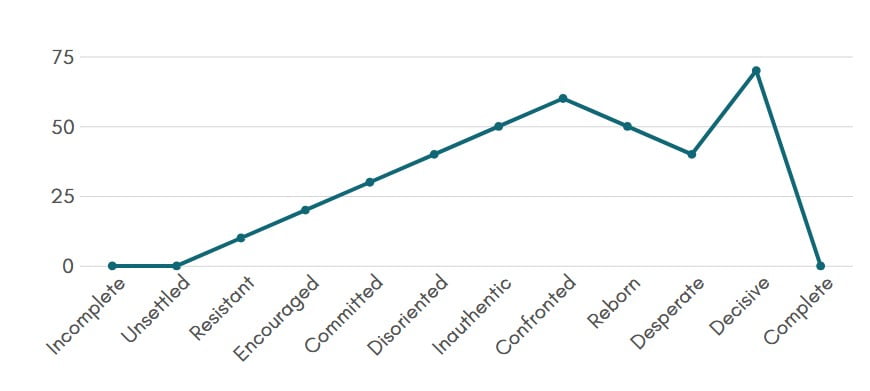You’ve settled on the idea you believe has potential for a great novel.
You’ve done your research.
You’ve spent a great deal of time developing your characters.
Maybe you even started writing your outline, but you’re frustrated.
You’re ready to start writing, and you’re confused about which plot structure will best fit your story.
We know the drill—your frustration is all too familiar for many beginning writers.
That’s why we created this plot structures resource to help give you a better idea which direction you’d like to head as you create the plot of your story.
As well as creating a list of plot templates for easy, practical use, we've also created a detailed guide to what plot outlines are, how they've evolved over time and looking at the advantage and disadvantages of using them.
Click here to skip straight to the plot templates, or read on...
The Ultimate Guide to Plot Outlines
Contents:
- What is a plot outline?
- The most basic plot outlines
- The Hero’s Journey / The Universal Storyline
- Doesn’t using this set of stages stifle creativity and turn us all into repetitive automatons?
- Who came up with these stages anyway and why should I trust them?
- Evolving the Hero’s Journey / Universal Plot Outline
- Genre specific plot outlines
- What are the benefits of writing a plot outline?
- What are the disadvantages of writing a plot outline?
- How to write a plot outline
- Plot Outline Templates
What is a Plot Outline?
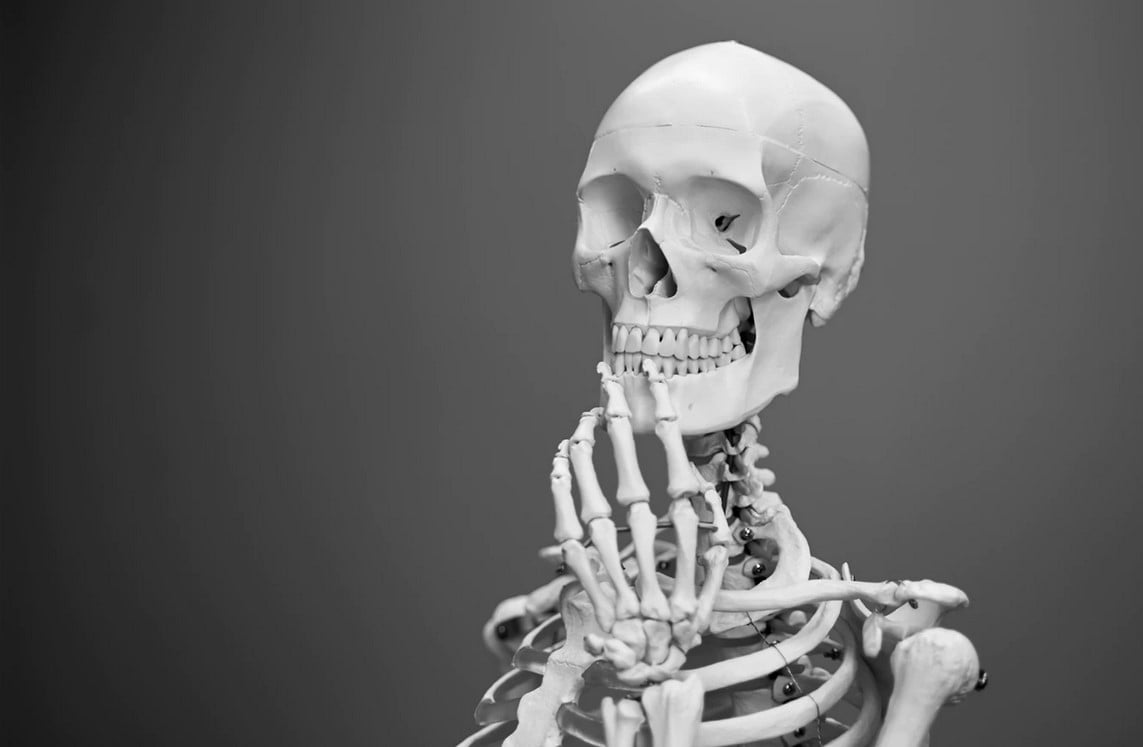
A plot outline is like your story’s skeleton. It’s the bones on which you hang the flesh, blood, sweat and tears of your story.
It sketches out the underlying structure of your novel: its key stages, including critical developments and pivotal moments.
It doesn’t list all of the chapters, or everything that happens in them. Its sticks to the heart of the story – which is usually the personal journey of the protagonist, from who they are at the beginning to who they are at the end.
For some people an outline may simply be a few ideas floating around their head, for others it may be a 50,000 word document.
For our purposes, we’ll assume a plot outline is a written document of a few pages, covering key stages and turning points.
The most basic plot structures
The simplest plot outline could be based on the three act structure:
- Beginning
- Middle
- End

For example:
- Beginning – Harry is a bullied orphan living with his aunt and uncle, who mistreat him
- Middle – He joins a magical school and learns of great friends, enemies and challenges
- End – He manages to stop an evil wizard from stealing an important artefact, and returns home confident and able to stand up for himself
But that’s simplistic to the point of being of limited use. So you may want to expand it into something like this:
- Status Quo
- Rising Action
- Climax
- Falling action
- Final Outcome
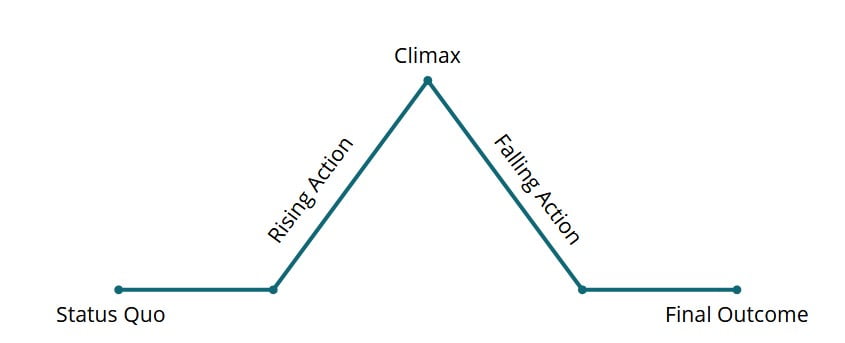
For many people, this is enough of a structure on which to hang the main points of their story. Using these stages will help ensure the story feels satisfying to a reader.
Imagine how a reader might feel if you wrote a story with the stages in this order:
- Climax
- Rising Action
- Final outcome
- Falling Action
- Status quo
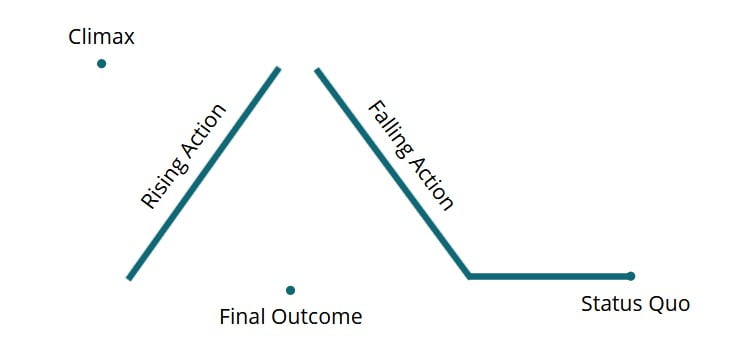
It hurts just to look at it. Imagine what it would be like to read.
Applying this distortion to the simplest of plot outline makes it clear why getting the stages out of order can be confusing, unsettling and even nonsensical.
This is an important lesson, because while the diagram above is almost laughable, it might not be so obvious when stages are out of order when using a more advanced structure. However, there’s a high chance that readers will still feel less engaged and emotionally involved.
The Hero’s Journey / The Universal Storyline
The most popular and widely used plot structure is probably the Hero’s Journey, which goes something like this:
- Ordinary World
- Call to adventure
- Refusal of the Call
- Meeting the Mentor
- Crossing the Threshold
- Tests, allies, enemies
- Approach the innermost cave
- The ordeal
- Reward
- Road Back
- Resurrection
- Return with Elixir
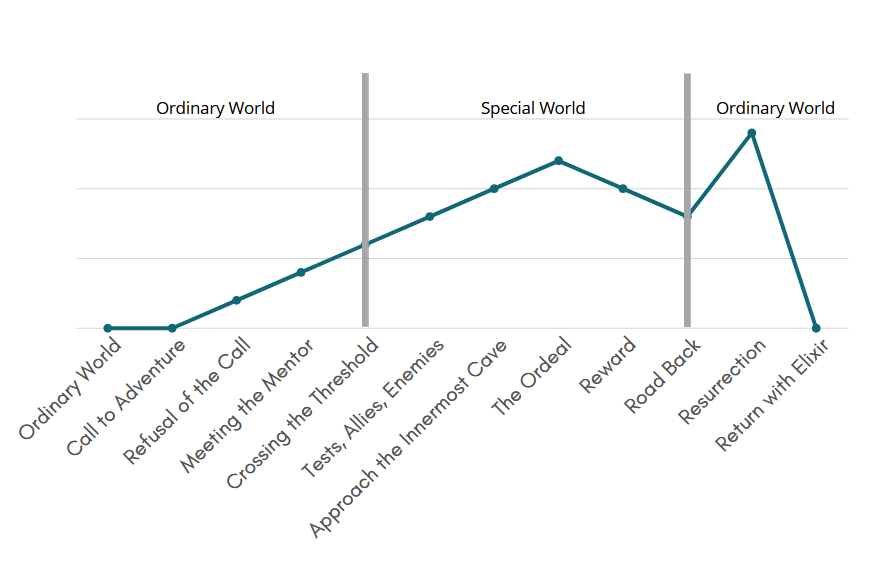
In this diagram, the higher the line, the higher the tension and stakes. The dip towards the end additionally represents a loss of hope.
Traditional diagrams depict the Hero’s Journey as a circle, but I find that doesn’t sit right with me, as it means the end point appears to be exactly the same as the start point.
For me the linear diagram better represents the concept the the hero returns ‘home’ (back to the baseline), but they are further forward than they were at the start.
Here’s a very brief explanation for each of these stages:
|
Ordinary World |
The protagonist is introduced in their normal everyday life |
|
Call to adventure |
Something happens to shake up the hero’s everyday life |
|
Refusal of the Call |
The hero often has doubts, just wants to stay in their safe existence |
|
Meeting the Mentor |
They meet someone who gives them advice that will be useful for the coming challenges |
|
Crossing the Threshold |
They change location or burn bridges in a metaphorical sense, meaning they cannot simply return to their old life as if nothing has happened |
|
Tests, allies, enemies |
They face various challenges, and make new friends |
|
Approach the innermost cave |
The hero prepares to battle terrible danger or inner conflict |
|
The ordeal |
The hero must face great demons, which could be internal or external, or both |
|
Reward |
The hero receives some kind of reward for facing their demons |
|
Road Back |
The hero begins their journey back to everyday life |
|
Resurrection |
The greatest battle and most dangerous encounter |
|
Return with Elixir |
The hero returns home triumphant
|
You can read about the stages of the Hero’s Journey in more detail here.
Before we go any further, let’s address some questions that writers sometimes raise with regards to the Hero’s Journey and other plot outlines.
Doesn’t using this set of stages stifle creativity and turn us all into repetitive automatons?

It’s important to realise that each of these stages can be interpreted in an infinite number of ways, leading to an infinite variety of stories.
At first, it’s easy to be misled (especially by the wording) that this template will force your story into a particular style.
For example, at the most fundamental level, the word ‘Hero’ may give the impression you have to present a sword wielding, brawny young man who longs for adventure - but this couldn’t be further from the truth.
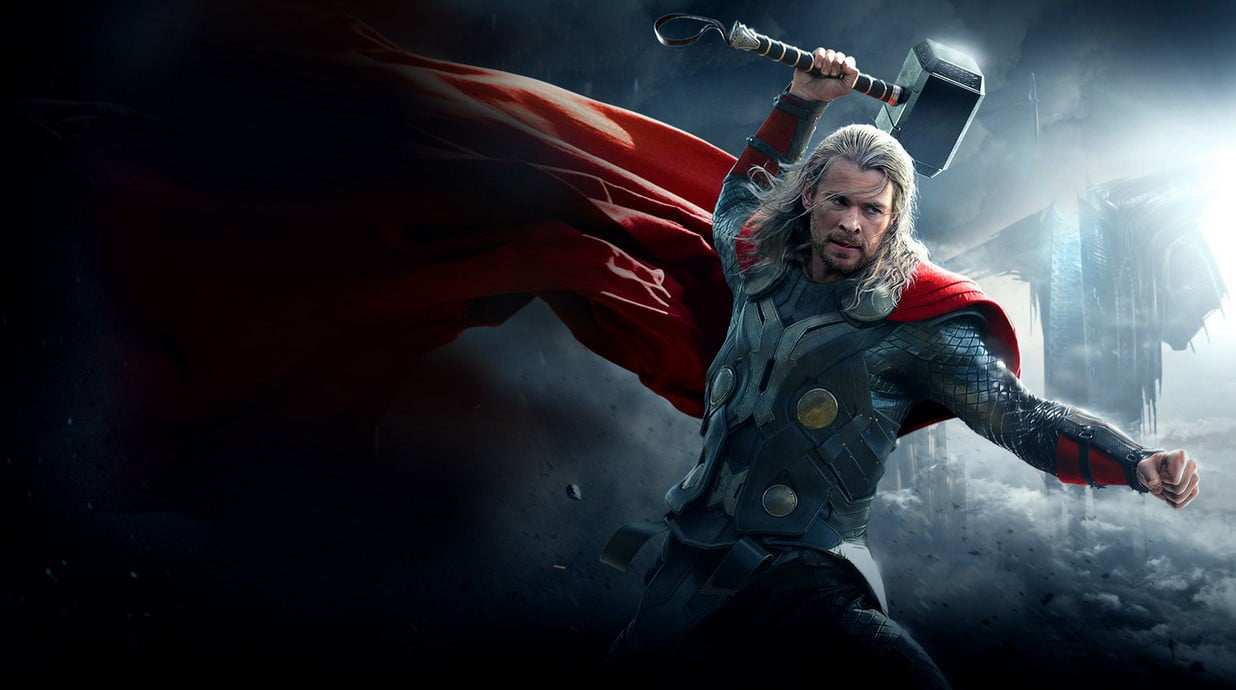
The ‘Hero’ just means the protagonist, and they don’t have to display any traditionally ‘heroic’ qualities at all. We are all the protagonist of our own experience, however flawed and morally questionable.
Similarly, the Call to Adventure doesn’t have to have anything to do with sirens, evil Kings or swordfights. It can be anything that unsettles and ordinary life.
So, while the hero could be a young man longing for exciting quests, and his call to adventure could be an old wizard telling him of a dragon who’s kidnapped a princess, it could equally be:
- A high school airhead who’s just been dumped and decides to go to law school to try to win her boyfriend back.
- A little girl who follows a rabbit down and hole, then has to find her way home.
- Or even a widowed fish who needs to find his missing son.
Click here for more examples of the Hero’s Journey in a range of stories.
If you start looking out for it as you watch movies and read books, you will start to see how varied the interpretations are, and how the same concepts that be found in all genres and mediums.
In fact, because of your own personal experience of life and the world, you couldn’t write a book that was the same as someone else by following these stages, even if you tried.
Who came up with these stages anyway and why should I trust them?
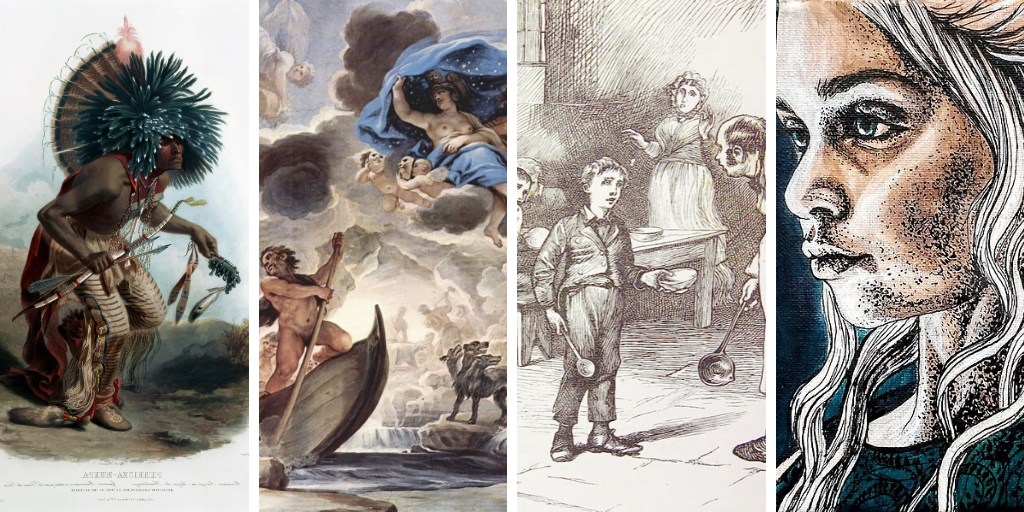
One of the most important things to remember when following the Hero’s Journey and its variations, is that nobody invented them.
An academic called Joseph Campbell is credited with analysing thousands of stories spanning the globe, from those told around tribal campfires to modern books and movies.
In doing so, Campbell identified similarities that emerged beyond all the borders and ages, and attempted to distil these common patterns into one fundamental ‘monomyth’. The Hero’s Journey is a modernised interpretation of that monomyth.
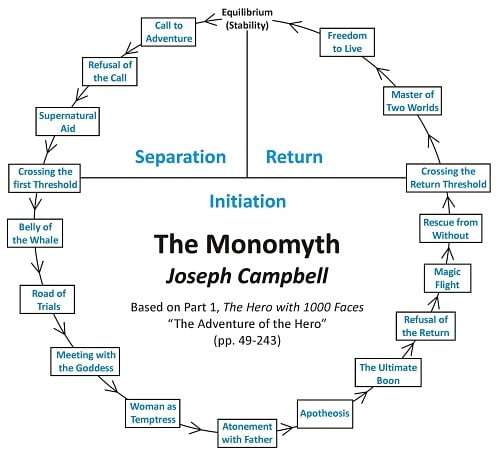
So, they are not a set of rules made up and laid out by some authority. They are a fundamental structure that emerged from the collective consciousness of our human psyche.
The success of the vast majority of bestsellers and box office huts is testament to the power of the Hero’s Journey to resonate with large numbers of people.
Cautions of the monomyth

Having said that… all interpretations we make of the world are shaped by our own experience, and the original monomyth laid out by Campbell certainly contains problematic terminology and elements.
Glaringly, there are those which focus on the traditionally male perspective and experience, but there are also issues with bias towards the western experience and attitudes of the time regarding dominance and individuality.
Campbell can’t be blamed for that, none of us can see the limitations of our own perspective because they are beyond our peripheral vision. However, it also means that we don’t need to treat his analysis as ‘sacred’.
And of course, the Hero’s Journey is already an interpretation of the original work, so it has already begun.
Despite these qualifications, disregarding the monomyth and Hero’s Journey would be throwing away some of a writer’s most useful tools.
And we can continue that work by evolving it to fit our changing experiences and attitudes to the world and our way of existing in it.
Of course, you could choose to throw it all out and start from scratch, creating your own stages, pacing and progression. But there is a much stronger chance you won’t tap into the collective unconscious; in which case you’ll need to work much harder to engage the audience.
Evolving the Hero’s Journey / Universal Plot Outline

Many have already begun this work, and created interpretations and variations which make it clearer that the emphasis is on a personal journey, rather than anything to do with men slaying dragons.
An excellent one is the Character Driven Hero’s Journey, as developed by Allen Palmer:
|
Incomplete |
Protagonist is incomplete |
|
Unsettled |
An outside force appears to challenge them |
|
Resistant |
Protagonist refuses to do the right thing |
|
Encouraged |
Protagonist is pushed in the right direction |
|
Committed |
They burn their bridges so there’s no going back |
|
Disoriented |
Protagonist faces unfamiliar challenges |
|
Inauthentic |
They are faced with their flaw but refuse to address it |
|
Confronted |
They are confronted with their flaw and cannot ignore it |
|
Reborn |
They demonstrate that they have changed |
|
Desperate |
complications ruin everything |
|
Decisive |
At the climax the protagonist must choose between their want and their need
|
|
Complete |
Rewards are morally just |
Genre specific novel outline templates
And of course, people who write in specific genres are able to identify stages and elements which tend to crop up consistently within their own genres, and have a positive effect on the popularity of their stories.
We’ve created a bunch of genre specific plot outline templates, including:
- Romance
- Detective Noir
- Character Driven Hero’s Journey
- Mystery / Crime Thriller
- Screenplay
- Short Story
You can access all of these below.
What are the benefits of writing a plot outline?
Stronger first draft
If you outline your plot before you start writing, you can be confident your first draft will have a solid structure from the outset, rather than hoping for it to emerge organically, or having to retroactively go and apply it
This will save time and effort when it comes to redrafting and editing towards your final manuscript.
Direction and Completion
Knowing where you’re going helps you get there.
Writing a novel is a mammoth task which can feel overwhelming. Having a plot outline helps break it down into manageable chunks, with clear goals.
It can keep you motivated and on track.
Frees up creativity
Contrary to stifling creativity, having a plot outline frees you up to let the words flow, because you don’t have to be preoccupied with the worry that you’re going to write 50,000 words then find yourself in a dead end.
What are the disadvantages of writing a plot outline?
Could take away the thrill of discovery
Many writers don’t want to know too much about their story before they start, as the knowing sucks out the excitement of discovering the story as they write.
And some successful writers report that they never plan before they start.
But when you analyse their work, you will usually discover that the stages are in fact. So what gives?
It’s not that they’re being dishonest, it’s that they have absorbed these patterns from their experiences of books, movies and life and are applying them sub-consciously.
If you don’t feel writing out a plot outline works for you, then it’s even more important to internalise the universal structures, so you can rely on your subconscious to take care of it.
Procrastination
Writers can sometimes be procrastinators to professional levels, so make sure you’re not doing your plot outline to death just to avoid starting your first draft.
But the fact is that there are certain things that tap into our human psyche. Skilled writers will subvert and break traditional structural conventions to great effect – but it’s unlikely they’ll do so by accident.
You have to know the rules before you can consistently break them effectively, so know about plot outlines and what they do is a great tool to have in your writer’s toolbox, whether you decide to use them in the end or not.
How to write a plot outline
Find a plot outline that suits you
Read through a range of plot outline templates and see which resonates with you the most.
Write a few sentences for each of the stages
For each of the stages write a few sentences, or a paragraph which describe how that stage manifests in your novel.
Tweak it
Read through the entire thing and make sure it flows and makes sense. Make adjustments for consistency.
Ongoing improvement
As you’re writing your first draft and subsequent drafts, treat your plot outline like a working document, not a set of commandments carved into stone.
If it needs tweaking and updating, that’s fine. You may decide to reorder the stages, add new ones, or remove some.
Don’t be too rigid
As with all rules of thumb, you can break the conventions to great effect – the important thing is that you know what you’re doing and why, rather than just fumbling because you don’t have the right tools in the first place.
Following the stages fairly closely is the easiest way to take advantage of the patterns of the collective unconscious. Deviating from them is to be encouraged, but you have to be aware of the impact it will have, and realise you may have to work harder and use other techniques to engage the audience and keep them emotionally hooked.
Good luck with your plot outlines! Please share your plot outlines and other plot outline resources in the comments!
8 Plot Outline Templates - Free Downloadable PDFs
The plot structures below are available as free downloadable PDFs, but there is a better way to use them.
They are all fully integrated into the Novel Factory novel writing software.
There, you can select a template from the dropdown menu and begin writing within the software.
You are given the option to add and delete your own stages, sort them into acts, and drag and drop them into the order you prefer.
It takes using these novel outline templates to a new level of efficiency.
Get a free trial of the Novel Factory to see it in action.
If you like these, you may also like our free book writing worksheets.
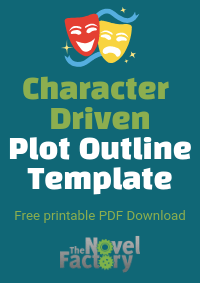
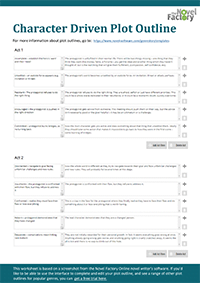
Character Driven Plot Outline
This story outline is driven by the development of a compelling character arc.
The protagonist begins with something missing from their existence, even though they may not be aware of it.
Through the story, they learn why they feel incomplete and must face their demons and deepest fears in order to evolve as a person and become whole.
Sample:
Incomplete - establish the hero's 'want' and their 'need'
The protagonist is unfulfilled in their normal life. There will be two things missing – one thing that they think they want (like money, fame, a Porsche – you get the idea) and another thing which they haven’t thought of, but is the real thing that will give them fulfillment. (compassion, self-confidence, etc).
Unsettled - an outside force appears (e.g. invitation or threat)
The protagonist’s world becomes unsettled by an outside force. An invitation, threat, or attack, perhaps.
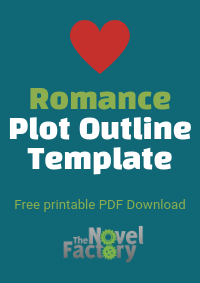
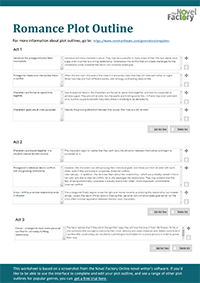
Romance Novel Story Outline
The classic romance story structure, including all the major story beats and complications.
Based on characters having personal character arcs and motivations that conflict with the romance aspect.
Sample:
Introduce the protagonist (who feels incomplete)
Introduce the main character’s world. They may be successful in many areas of life, but clearly, there’s a gap when it comes to a loving relationship. Foreshadow the conflict that will create challenges for the romance to come. Establish the hero’s non-romance based goal.
The protagonist meets love interest but there is conflict
When the two main characters first meet it is extremely likely that they will hate each other on sight. Show how they are from different worlds, with strongly contrasting views on life.
Characters are forced to spend time together
Due to external factors, the characters are forced to spend time together, and even to cooperate to achieve a goal. They are still at odds, but the sparks are kindling some fire… A friend may even comment on it, but the couple-to-be both hotly deny there is an attraction.
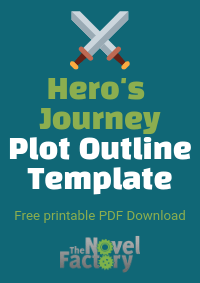
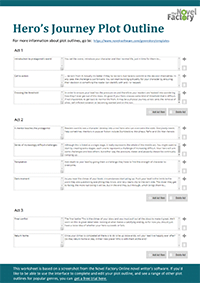
Hero's Journey Novel Plot Outline
The Hero's Journey, as proposed by Joseph Campbell, trimmed to the bone and applicable across all genres - not just sword-wielding fantasies.
Sample:
The Ordinary World
To begin with, you set the scene and introduce the main character. This is the place to establish what’s missing from the main character’s life, and give hints about the story to come.
Call to Adventure
An external force challenges the main character. This is usually an invitation or a threat.
Refusal of the Call
The protagonist often expresses reluctance to answer the Call to Action. They may be afraid or feel poorly equipped for such a challenge. Sometimes the reluctance is expressed by a supporting character, not the hero.
Meeting with the Mentor
The mentor is a character of authority to the protagonist. They provide advice and useful gifts, such as weapons or talismans. The mentor often reflects the tone of the story - a tragedy will have a one who is toxic or destructive (or one who is already dead), a children's fairytale will have a benevolent all-knowing one, a dystopia may have an unreliable one. The mentor is usually a recurring character.
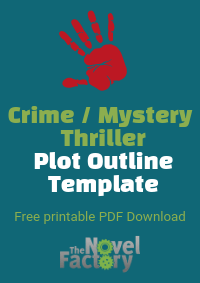
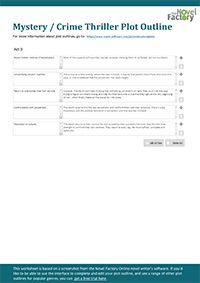
Mystery / Crime Thriller Plot Outline
A fairly detailed structure that explains how to develop the sleuth's inner character journey alongside solving the crime and uncovering deeper conspiracies.
Sample:
Present the crime
Mysteries and crime thrillers often begin with a prologue in which the inciting crime takes place. The first crime is very likely to be a murder or kidnapping. This is from a POV that is not the main protagonist, it may be from the point of view of the victim, the killer, or an omniscient narrator.
Introduce the sleuth
Next, we meet the sleuth, who is the protagonist. This person is often a professional detective, but not always. Sometimes they are a normal person thrust into a situation that gives them no choice but to take action – usually because someone they love is missing or threatened.
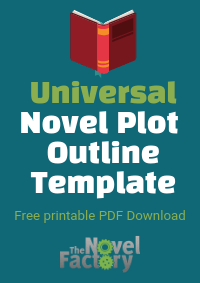
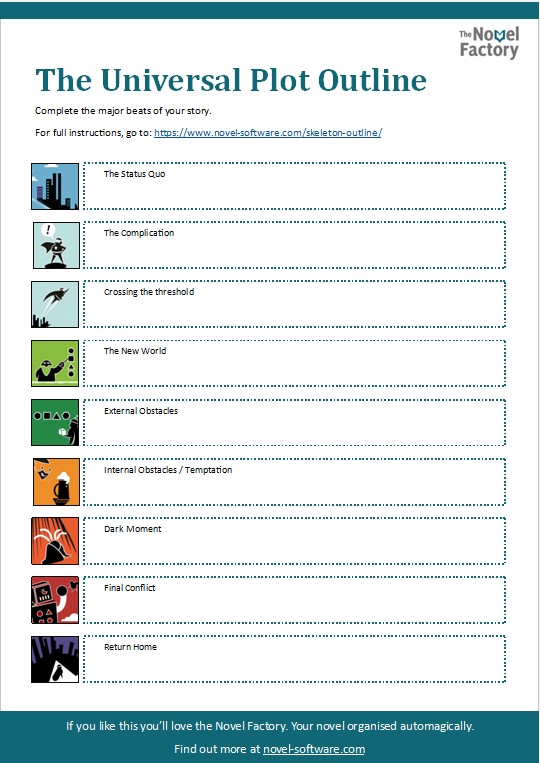
Universal Novel Plot Outline
Based on the hero's journey, but rejigged to make the terminology more generic and easy to apply across genres.
Sample:
Act 1
The Status Quo
Introduce the main character’s world and establish their want and their need. The character clearly has things missing from their lives and they are unsatisfied with their current existence.
The Complication
Something happens to shake the character’s world and offers them an opportunity, or creates a threat.
Crossing the Threshold
In pursuit of the goal, the character crosses some kind of barrier (could be physical but doesn’t have to be), which means it is not possible to return to their old life.
Act 2
A New World
The character is now in a new and unfamiliar world, trying to navigate unknown rules and challenges.
External Obstacles
The character must face a series of conflicts, each of increasing difficulty and stakes. Some they will win, some they will lose.
Internal Obstacles (temptation)
The most compelling stories will pit main characters against their inner demons, forcing them to overcome them in order to become a better person.
Dark Moment
In order for the high of the climax to have the greatest effect, you should precede it by taking your character as low as they can go. Despite all the progress they’ve made against external and internal obstacles, something should happen at the end of the second act which makes everything fall apart and makes them certain that all is lost.
The Final Conflict
This is the final battle where they throw everything they’ve learned and everything they’ve become, against the great enemy - and in the vast majority of cases, they will be victorious.
The Return Home
Bring your readers back down to earth after the climax, show the hero's new normal and tie up any loose ends.
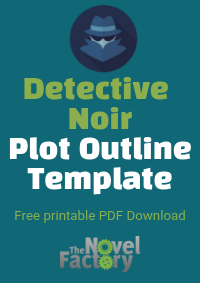
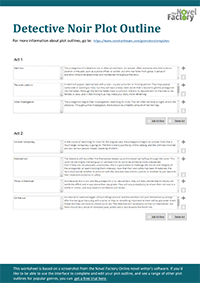
Detective Noir Novel Plot Outline
Drawn from the detective noir / hard-boiled genres, a dark mystery structure with dark undertones and plenty of betrayal.
Sample:
Start Low
The protagonist of a detective noir is often an anti-hero. An outcast, often someone who held a heroic position in the past, such as a police officer or soldier, but who has fallen from grace. A sense of alienation should be established and maintained throughout the story.
The siren walks in
A client will appear, seeking help with a case – usually a murder or missing person. They may appear vulnerable or wanting to help, but they will have a deep, dark secret that is bound to get the protagonist into hot water.
Although the femme fatale trope is common, there is no requirement for the siren to be female, or sexy, and in fact, mixing it up may make your story more refreshing.
Initial investigation
The protagonist begins their investigations, searching for clues. This will often be done at night, and in the shadows. Throughout the investigation, there should be a healthy amount of red herrings.
Note - click here to read about the difference between hard-boiled and noir.
And you can read more about the elements of detective noir here.
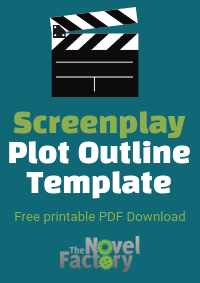
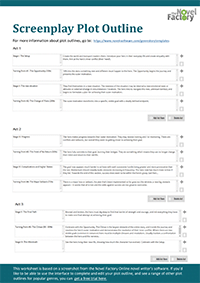
Screenplay Plot Outline
Based on Hollywood Blockbusters.
Sample:
Stage I: The Setup
Create the world and transport readers there. Introduce your hero in their everyday life and create empathy with them. Hint at the hero’s inner conflict (their ‘need’).
Turning Point #1: The Opportunity (10%)
10% into the story something new and different must happen to the hero. The Opportunity begins the journey and presents outer motivation.
Stage II: The new situation
They find themselves in a new situation. The newness of the situation may be internal (a new emotional state or attitude) or external (change in circumstances / location). The hero tries to navigate this new, unknown territory and begins to formulate a plan for achieving their outer motivation.
Turning Point #2: The Change of Plans (25%)
The outer motivation transforms into a specific, visible goal with a clearly defined endpoint.
Act 2
Stage III: Progress
The hero makes progress towards their outer motivation. They may receive training and / or mentoring. There are conflicts and setbacks, but overall they seem to getting closer to achieving their goal.
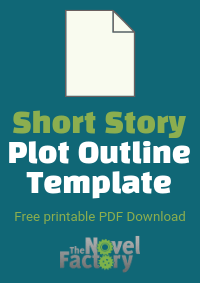
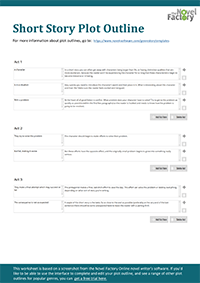
Short Story Plot Outline
A seven-point system for writing a short story.
Sample:
A character
In a short story you can often get away with characters being larger than life, or having distinctive qualities that are more exuberant, because the reader won’t be experiencing the character for so long that these characteristics begin to become tiresome or irritating.
Is in a situation
Very quickly you need to introduce the character’s world and their place in it. What is interesting about this character and their life? Make sure the reader feels excited and intrigued.
With a problem
At the heart of all good fiction is conflict. What problem does your character have to solve? Try to get to the problem as quickly as possible (within the first few paragraphs) so the reader is hooked and needs to know how the problem is going to be resolved.
They try to solve the problem
The character should begin to make efforts to solve their problem.
But fail, making it worse
But these efforts have the opposite effect, and the originally small problem begins to grow into something really serious.

